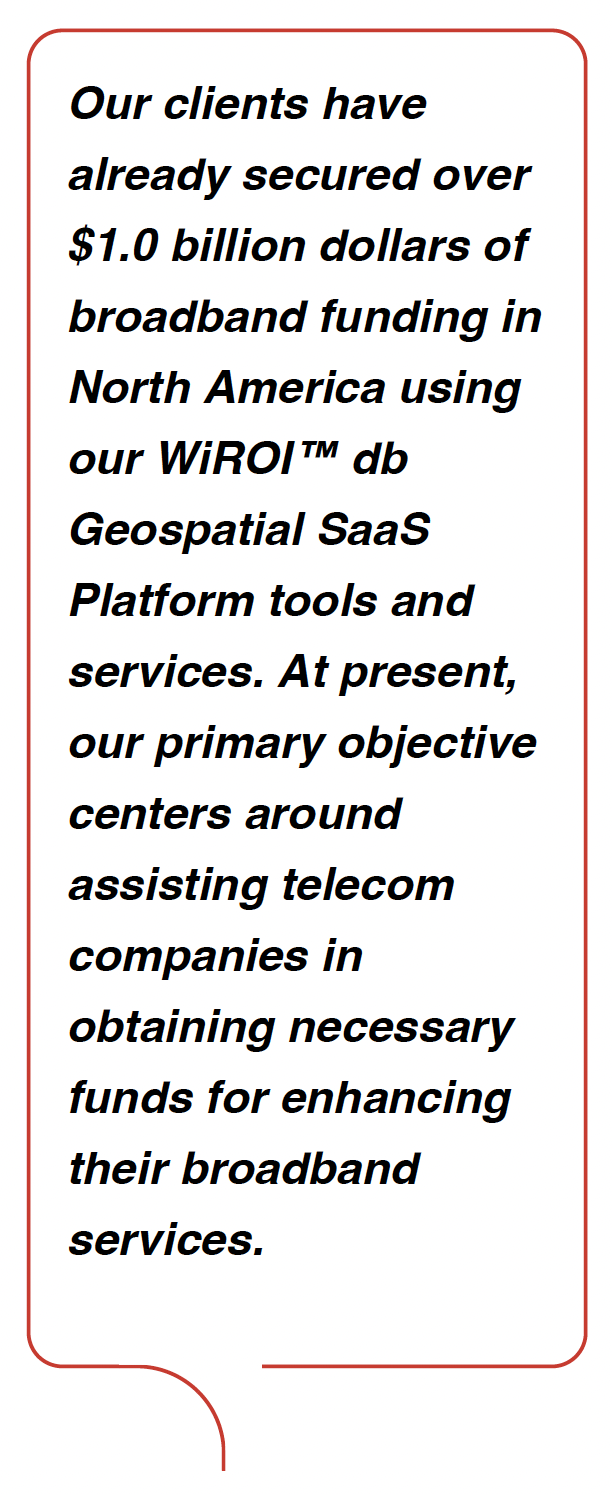 The current transition from wireless and copper technologies to fiber optic technology for rural networks is currently funded by the U.S. government. However, for telecom providers to secure that funding, they need access to advanced big data analytics and geographic information system (GIS) mapping skills to pinpoint user locations and design the necessary networks. This presents both a challenge and an opportunity for telecoms, whose primary focus is on networking and improving capabilities.
The current transition from wireless and copper technologies to fiber optic technology for rural networks is currently funded by the U.S. government. However, for telecom providers to secure that funding, they need access to advanced big data analytics and geographic information system (GIS) mapping skills to pinpoint user locations and design the necessary networks. This presents both a challenge and an opportunity for telecoms, whose primary focus is on networking and improving capabilities.
Extensive mapping and data analysis are essential to receive grants, but they are costly to conduct, especially for smaller companies. Wireless 20|20, a telecom consultancy, offers specialized software tools for mapping and data analysis, aiding telecoms in securing these government grants. “Possessing vast experience in advisory services, we are proud to have catered to over 200 clients globally. At present, our primary objective centers around assisting telecom companies in obtaining necessary funds for enhancing their broadband services,” says Haig Sarkissian, principal consultant at Wireless 20|20. Its team is actively facilitating the process of applying for state and federal funding, benefiting numerous clients in their pursuit of expanding their broadband networks. Wireless 20|20 offers two critical tools for enhancing its operations. WiROI™ db Geospatial is a state-of-the-art SaaS platform that taps into a comprehensive database, including FCC BDC Fabric data, precise location information, and U.S. Census Bureau data, all presented in an intuitive ‘Excel-like’ interface. It provides a wealth of data on broadband service areas in the U.S., highlighting the coverage of service providers, their technology, and speeds at different locations. This aids in assessing service availability and helps operators pinpoint ideal locations for deploying fiber and wireless broadband networks for subsidy grants. The data integrates seamlessly with WiROI™ business case analysis and network planning tools, empowering operators to make well-informed investment decisions, a valuable resource for investors looking to optimize broadband projects. On the other hand, ChatGIS™ is an AI-powered natural language interface that enables users to ask questions in English and get instant responses. This database offers a user-friendly interface for effortless broadband data exploration. For example, large companies operating across multiple states must identify underserved areas and evaluate the costs of providing the necessary infrastructure. These tools streamline the process and maximize efficiency for operators and investors alike.
 Clients can use WiROI™ db to export the data that includes the unserved and underserved locations. Now determining the expenses associated with constructing fiber connections in those areas usually requires several days to complete, especially when dealing with numerous locations. It involves conducting surveys to ascertain the number of locations requiring fiber connectivity, the distance of fiber installation required, and evaluating if utility poles are available for optimal connection or if underground digging is necessary. This analysis will encompass hundreds of thousands of locations and is a time-consuming process that often spans several weeks or even months. The company’s software is designed to simplify the process of connecting dots by using V.Fast, a proprietary Steiner Algorithm. This computational optimization algorithm calculates the most efficient and cost-effective way to connect multiple locations in just 15 seconds, providing quick and accurate results.
Clients can use WiROI™ db to export the data that includes the unserved and underserved locations. Now determining the expenses associated with constructing fiber connections in those areas usually requires several days to complete, especially when dealing with numerous locations. It involves conducting surveys to ascertain the number of locations requiring fiber connectivity, the distance of fiber installation required, and evaluating if utility poles are available for optimal connection or if underground digging is necessary. This analysis will encompass hundreds of thousands of locations and is a time-consuming process that often spans several weeks or even months. The company’s software is designed to simplify the process of connecting dots by using V.Fast, a proprietary Steiner Algorithm. This computational optimization algorithm calculates the most efficient and cost-effective way to connect multiple locations in just 15 seconds, providing quick and accurate results.
“Our software is 60 times faster than others in the industry, and this speed is crucial when dealing with large-scale projects like designing fiber networks for hundreds of thousands, as multiple iterations are necessary to pinpoint the optimal clusters, and speed is essential,” says Sarkissian. The company’s AI software utilizes Google map technology and helps clients obtain Google’s street view images and compare them to find the presence of telecom utility poles. This software is capable of identifying and marking the streets where these poles are located, as well as determining whether the fiber network installed is aerial or underground. Each segment is labeled as aerial vs. underground, since building underground networks is about three to five times more expensive, compared to building aerial networks. This labeling helps clients understand the cost implications of constructing a network and calculate the amount of subsidy they should request. Needless to say, Wireless 20|20 offers an indispensable service for the telecom industry. Its powerful tools and advisory services are valuable assets in helping companies make informed decisions and navigate through complex processes, which are crucial for businesses to optimize their operations and stay ahead in the competitive telecommunications market.
Reprinted from https://www.telecombusinessreview.com/wireless
